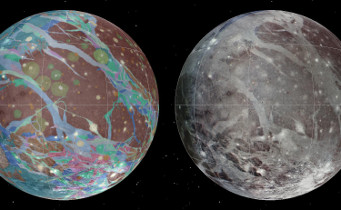Scientists have produced the first geologic map of Ganymede, the largest moon in our Solar System.

A geologic map of Ganymede provided by NASA's Voyager 1 and 2 spacecraft and NASA's Galileo spacecraft.
USGS Astrogeology Science Center / Wheaton / NASA / JPL-Caltech
If you ask me the highlight of Jupiter isn’t its giant Red Spot, its windswept cloud layers, or even its sheer size, but instead its brilliant moons with their spewing volcanoes, pristine surfaces, and utter beauty.
For the first time, Ganymede, Jupiter’s largest moon — and, in fact, the largest moon in the solar system (clocking in with a diameter of 3,280 miles, making it larger than the planet Mercury and almost as large as Mars) — has been fully charted.
The comprehensive map is the result of a project led by Geoffrey Collins (Wheaton College) with a little help from NASA’s Voyager 1 and 2 spacecraft (flybys in 1979) and the Galileo orbiter (1995 to 2003). Although researchers had previously pieced together a global image mosaic, it fell to Collins and his team to organize the views into discrete terrain types.
The surface area of Ganymede is more than half of the land area on Earth, providing a wealth of diverse geologic features. Now planetary scientists can assess all of the incredibly varied terrain on Ganymede from an integrated perspective.
The colorful map provides detailed evidence for three periods in the colossal moon’s history: an early phase where the icy crust was bombarded with meteorites, a phase dominated by great tectonic upheaval, and a late phase with a gradual drop in heat flow and further impact cratering.
You can easily see the two major terrain types: dark highly cratered regions and swaths of lighter, somewhat younger regions that crisscross 65% of the surface.
Even after decades of study, researchers can’t decide whether the bright terrain, which typically is packed with long grooves and ridges, resulted from tectonic forces within the crust or from repeated outpourings of slushy ice flows from the interior. In 1996, the Galileo spacecraft discovered Ganymede’s magnetic field, powered by a possible liquid iron core or a thin ocean beneath the icy crust. The latter may also lead to geologic change on the surface.
“This map illustrates the incredible variety of geological features on Ganymede and helps to make order from the apparent chaos of its complex surface,” says team member Robert Pappalardo of NASA's Jet Propulsion Laboratory.
Watch a 360° rotation of Ganymede in all its detailed glory below:
ESA’s upcoming Jupiter Icy Moons Explorer (JUICE) mission is slated to launch in 2022 and orbit Ganymede around 2032. This map will likely aid mission planning. Ganymede is visible from Earth as one of the 4 Galilean moons seen alongside Jupiter (with Io, Europa, and Callisto). Jupiter is bright in tonight’s sky and is easy to spot with its 4 stunning moons in a decent pair of binoculars or a small telescope. For more information read JPL’s press release or check out the detailed brochure provided by the U. S. Geological Survey.
 6
6
Comments
Anthony Barreiro
February 14, 2014 at 4:00 pm
Thanks for this interesting report. I don't understand what is being represented by the different colors on the map and video. A legend would be helpful. I read the JPL press release and the USGS brochure. The brochure describes the history and current geology of Ganymede, but it doesn't contain a legend for the map. Since this came from the US Geological Survey, there must be a legend somewhere!
You must be logged in to post a comment.
Peter
February 14, 2014 at 5:21 pm
According to legend, Hebe was dismissed from her office in consequence of a fall which she met with one day when in attendance on the gods. Her successor was Ganymede, a Trojan boy whom Jupiter, in the disguise of an eagle, seized and carried off from the midst of his playfellows on Mount Ida, bore up to heaven, and installed in the vacant place.
You must be logged in to post a comment.
Anthony Barreiro
February 14, 2014 at 5:50 pm
Peter, have you ever noticed that many dictionary entries provide more than one definition for the same word?
You must be logged in to post a comment.
Mike W. Herberich
February 15, 2014 at 10:39 am
This is hilarious. To me, at least! Peter, were you being serious or just pulling Anthony's leg by intentionally confounding "legend" and "legend"? A very good demonstration of how language is at the center of and may be used or fall prey of confusing, rather than enlightening issues. Creating situations and issues instead of clearing issues. If that was the intention it was an ingenious demonstration. If it was not ... well, I'll leave it to anyone to name it properly.
You must be logged in to post a comment.
Peter
February 15, 2014 at 11:57 am
I’m with you, Anthony. There is a time and place for everything, and a legend would seem to go with the coloration. It definitely resembles Earth‘s continents-and-oceans, only frozen, but how much of that is color-bias?
You must be logged in to post a comment.
J Hanford
February 15, 2014 at 12:59 pm
Thanks for this interesting article Shannon. I've read other articles you have written for Universe Today and astrobites and look forward to your future work in S&T.
You must be logged in to post a comment.
You must be logged in to post a comment.